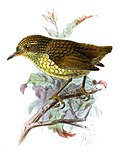Ailuroedus
| Ailuroedus | |
|---|---|

| |
| Scientific classification | |
| Domain: | Eukaryota |
| Kingdom: | Animalia |
| Phylum: | Chordata |
| Class: | Aves |
| Order: | Passeriformes |
| Family: | Ptilonorhynchidae |
| Genus: | Ailuroedus Cabanis, 1851 |
| Type species | |
| Ptilonorhynchus smithii Vigors & Horsfield, 1827=Lanius crassirostris Paykull, 1815 | |
| Species | |
|
see text | |
Ailuroedus is a genus of birds in the bowerbird family, Ptilonorhynchidae, native to forests in Australia and New Guinea. The common name, catbird, refers to these species' "wailing cat-like calls".[1] The scientific name Ailuroedus is derived from the Greek 'ailouros', meaning cat, and 'eidos', referring to form (or perhaps from oaidos, singer).
Taxonomy
[edit]The genus Ailuroedus was introduced in 1851 by the German ornithologist Jean Cabanis to accommodate a single species, Ptilonorhynchus smithii Vigors and Horsfield.[2] This is a junior synonym of Lanius crassirostris Paykull, 1815, the green catbird.[3] The genus name combines the Ancient Greek αιλουρος/ailouros meaning "cat" with αοιδος/aoidos or ωδος/ōdos meaning "singer".[4]
Traditionally, the Ailuroedus catbirds were classified as three species. However, a 2015 phylogenetic and morphological article by Martin Irestedt and collaborators revealed seven new species, leading to a total of ten distinct species.[5] In the same study, the results confirmed that the catbirds are divided into two major clades, a lowland group consisting of the New Guinean white-eared catbird, and a mid-mountain clade including the black-eared catbird and the Australian green catbird.[5]

Species
[edit]The genus contains ten species:[6]
- Ochre-breasted catbird (Ailuroedus stonii)
- White-eared catbird (Ailuroedus buccoides)
- Tan-capped catbird (Ailuroedus geislerorum)
- Green catbird (Ailuroedus crassirostris)
- Spotted catbird (Ailuroedus maculosus)
- Huon catbird (Ailuroedus astigmaticus)
- Black-capped catbird (Ailuroedus melanocephalus)
- Northern catbird (Ailuroedus jobiensis)
- Arfak catbird (Ailuroedus arfakianus)
- Black-eared catbird (Ailuroedus melanotis)
Description
[edit]Catbirds are characterize by ivory-colored bill with the hooked maxilla, large head, green dorsal plumage, ventral spotting, powerful grasping claws and fig-eating habit.[7]
In contrast to the other genera within the Ptilonorhynchidae family, all of the Ailuroedus catbirds lack marked sexual dimorphism, are pair bonded, monogamous breeders, with both parents caring for the offspring.[1][8] They form pair bonds in which the male helps to build the nest, and have simple arboreal chasing displays, without bowers or stages.[8]
References
[edit]- ^ a b Rowland, Peter (2008). Bowerbirds. CSIRO Publishing. p. 7. ISBN 978-0-643-09420-8. Retrieved 2009-05-07.
- ^ Cabanis, Jean (1850–1851). Museum Heineanum : Verzeichniss der ornithologischen Sammlung des Oberamtmann Ferdinand Heine, auf Gut St. Burchard vor Halberstadt (in German and Latin). Vol. 1. Halberstadt: R. Frantz. p. 213, footnote. For the publication date of volume 1 see: Dickinson, E.C.; Overstreet, L.K.; Dowsett, R.J.; Bruce, M.D. (2011). Priority! The Dating of Scientific Names in Ornithology: a Directory to the literature and its reviewers. Northampton, UK: Aves Press. pp. 80–81. ISBN 978-0-9568611-1-5.
- ^ Mayr, Ernst; Greenway, James C. Jr, eds. (1962). Check-List of Birds of the World. Vol. 15. Cambridge, Massachusetts: Museum of Comparative Zoology. p. 172.
- ^ Jobling, James A. "Ailuroedus". The Key to Scientific Names. Cornell Lab of Ornithology. Retrieved 30 May 2025.
- ^ a b Irestedt, M.; Batalha-Filho, H.; Roselaar, C.S.; Christidis, L.; Ericson, P.G.P. (2016). "Contrasting phylogeographic signatures in two Australo-Papuan bowerbird species complexes (Aves: Ailuroedus)". Zoologica Scripta. 45 (4): 365–379. doi:10.1111/zsc.12163.
- ^ Gill, Frank; Donsker, David; Rasmussen, Pamela, eds. (February 2025). "Lyrebirds, scrubbirds, bowerbirds, Australasian treecreepers, Australasian wrens". IOC World Bird List Version 15.1. International Ornithologists' Union. Retrieved 30 May 2025.
- ^ Beehler, Bruce McPherson; Pratt, Thane K. (2016). Birds of New Guinea: distribution, taxonomy, and systematics. Princeton (N.J.): Princeton university press. ISBN 978-0-691-16424-3.
- ^ a b Gregory, Phil (2020). Birds of Paradise and Bowerbirds: An Identification Guide. Princeton University Press. p. 323. ISBN 9780691202143.

